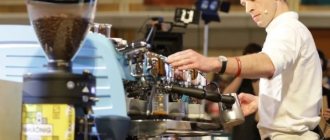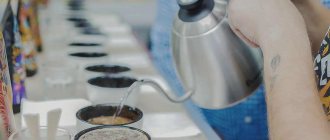Coffee dosing
- Holders should always be in the espresso group of the machine to ensure uniform heating;
- It is necessary to grind coffee only immediately before preparing espresso. No pre-ground coffee in the hopper!
- Before grinding a portion of coffee into the holder, it must be wiped clean and dry from the inside.
- Always grind the same amount of coffee into the holder (after adjusting the grinding).
- Always grind coffee into the holder evenly (a mound of coffee in the center of the holder).
- You should grind coffee into the holder without loss.
About the profession
A barista specializes in creating different types of coffee. He also prepares other drinks that are created on its basis. While working, the barista uses various types of equipment. In particular, we are talking about special coffee machines. So-called grinders and special steam generators.
In addition to the fact that the barista must prepare delicious coffee, he must decorate it beautifully. In order to subsequently submit it to your client.
What does barista mean?
Barista is an Italian word. Translated, it means a specialist who stands behind the bar. At the same time, the current formulation is not suitable for the specialty. Because it doesn’t reflect the essence of what a barista does.
A barista's only specialty is interacting with coffee. Cook and serve it. However, in the CIS countries, a barista can not only prepare coffee, but also have related responsibilities. For example, he can wash dishes (coffee cups). And also serve coffee to visitors of the establishment.
A barista must be able to prepare many types of coffee
There are a huge number of types of coffee in the world. In addition to the standard ones (Americano, cappuccino, latte), there are also exotic ones. The barista should know the recipes for most of these types of coffee.
A specialist must have a perfect understanding of his field. He must know how to interact with grains. How to dry them and store them. And also how they should be fried. And grind.
A barista must know a specific number of coffee recipes. Usually - at least forty. In addition to the fact that the barista must know the recipes, he must also be able to prepare coffee according to them. So that it turns out delicious and lifts the mood of customers.
The barista must be a subtle psychologist
The barista must have psychological skills. He must feel people. Understand what type of coffee they need at one time or another. This skill will be useful if the client comes to a coffee shop or restaurant and does not know which option to choose.
The barista must be able to use the equipment
Without the appropriate equipment, a barista is unlikely to be able to make delicious coffee. To master a profession, a teenager will have to learn to use different types of equipment. In particular, a coffee maker, a so-called pitcher (this is a special type of container into which milk is poured) and a coffee machine. Also, the teenager will have to master a tool called a grinder (this is a special coffee grinder).
Just knowing how to use instruments is not enough. The teenager will have to use certain tools professionally. To make coffee efficiently.
The barista must understand the types of coffee
A barista must have extensive knowledge of his specialty. He must understand how certain devices work. He must understand coffee terminology. Understand what types of grains there are. And also what types can be used to prepare certain types of coffee.
Also, the specialist must understand the technical side of the issue. He must understand how various factors influence the taste and smell of coffee. In particular, grinding, as well as roasting and the temperature of the water used to prepare this or that type of coffee.
About barista education
There is no narrowly focused specialty in which baristas can be trained professionally. However, a teenager can master a standard education, which will be useful when working in this area. In particular, recommend that your teenager graduate from college or university with a degree in “Waiter, Bartender.” Also, a teenager can master any other specialty that is in one way or another related to public catering.
In large cities you can find private barista courses. Sometimes they are held by various large cafes and restaurants. You have to pay money so that your teenager can study here. However, the result will please you. A teenager will be able to get a promising profession in which he can earn a sufficient amount of money.
All courses offered to teach the barista profession are private. Be sure to read reviews about them on the Internet. This will allow you to understand what courses you should send your teenager to. And which ones will not bear fruit. And the teenager will simply waste time and money.
Making espresso
- Before inserting the holder into the group, you should run it for 2 seconds to warm up and clean the group;
- Press the pour button without delay, otherwise the coffee will burn;
- The extraction begins as soon as the button is pressed, and it is from this moment that the time must be counted, while the coffee itself can be poured after some time (2 - 5 seconds).
- You should stop pouring when the espresso stream becomes lighter and loses its texture (flows like water).
- Espresso crema disappears within 30 seconds, so it should be served within 15 seconds with a glass of water.
IMPORTANT! Making a proper, delicious cup of coffee is easy. It's hard to make 10 cups of coffee consistently well! To do this, you should monitor and control your actions, work with coffee and on equipment every time.
Is it worth hiring an inexperienced barista?
If a candidate without experience is hired, then you need to be prepared that it will take some time to train him. And then practice, which is gained in the process of work. At first, a newbie will not have high quality and speed of service. The coffee business cannot avoid this.
In the future, the employee may leave the establishment for various reasons. To prevent this, when applying for a job, you should draw up a contract and specify the conditions in it.
It should be borne in mind that young specialists are very vulnerable due to their inexperience and uncertainty, so you need to show tact and patience towards a newcomer. If his resume says stress-resistant, this does not mean that he can handle all stressful situations.
For a barista to grow into a professional, it takes the efforts of not only the beginner, but also the cafe manager and the entire team.
But, there is every chance to get your own coffee bartender, who will be trained for a specific establishment. With his eyes closed he will be able to navigate the cafe, because from the very beginning he knows where everything is. Can easily find replacements for ingredients that are temporarily unavailable. It grows and develops along with the business and forms a single whole with it.
If you don’t want to waste time training a new person, then you can hire a professional. Such a person will be able to independently adapt to the specifics of the establishment, but will find an approach to the guests. In addition, he has many ideas that can be brought to life. But here it should be remembered that such a person works as long as he is interested. Once interest wanes, the cafe may lose an employee.
Therefore, in order to retain a professional, you need to create conditions for self-improvement.
As you can see, there is no clear answer whether or not to take a newcomer to your team. Each leader makes this decision independently. However, we must remember that the main thing is not only to find a barista, but also to retain him.
For you:
7 points for a successful coffee shop launch
Working with grinding
- Grinding is usually the hardest part for a new barista and requires the most dedication.
- The grind should be changed when the espresso extraction time does not meet the standard, that is, less than 20 seconds or more than 30, and therefore the taste does not meet the standard:
IF THE ESPRESSO EXTRACTION TIME IS LESS THAN 20 SECONDS, THE COFFEE WILL HAVE MORE ACIDITY.
IF THE ESPRESSO EXTRACTION TIME IS MORE THAN 30 SECONDS, THE COFFEE WILL BE MORE BITTER.
THE BARISTA'S JOB IS TO ACHIEVE BALANCE IN THE CUP AND ALSO REVEAL THE FLAVORS OF A PARTICULAR MIXTURE, AND TO DO THIS, HE WORKS WITH THE GRIND.
THEREFORE, IF THE EXTRACTION TIME IS LESS THAN 20 SECONDS, THE GRINDING NEEDS TO BE REDUCED (FINE), IF THE EXTRACTION TIME IS MORE THAN 30 SECONDS, THE GRINDING SHOULD BE INCREASED (GROSSO).
- Before deciding that it is necessary to change the grind, you should make sure that the “tablet” (used coffee) is of the correct density (like plasticine when pressed, it should not fall apart after being knocked out of the holder, there are no air chambers).
- As you adjust the grind, it is important to monitor the quality of the extraction. Extraction is the time during which the coffee components (flavor, aroma, acids, sugars, etc.) “come out” from the compressed coffee into the cup. Extraction ends when the compressed coffee runs out of these components, as indicated by a change in color and texture.
- Also, do not forget that the volume of the drink must be at least 30 ml.
- The decisive criterion for assessing whether the grind is satisfactory is the taste of the espresso (see Coffee Standards).
What should a barista know and be able to do?
Relatively recently, the term barista has appeared among new words. Literally translated from Italian, this means working behind the bar.
It is important for any coffee shop to have an experienced barista who must:
- be able to distinguish different types of coffee beans;
- know how and under what conditions coffee is grown;
- what methods are used when collecting and processing grains;
- understand the degrees of roasting;
- be able to distinguish the aromas and tastes of a drink;
- know how to store ground and bean coffee;
- be able to choose the right grind;
- prepare coffee using any equipment;
- apply various technologies and standards in preparing a coffee drink.
In addition to the ability to operate coffee machines and knowledge in the field of coffee, you need to serve the client well. The drink must be served correctly and, if necessary, the barista must be able to explain to the customer how this drink differs from others.
A professional will be able to correctly select the utensils for serving coffee, and the espresso barista can also decorate the drink by depicting any design on the foam. Not all coffee brewers have these skills.
Working with milk
- The milk is whipped in two stages: first you should beat the menu (1 - 3 seconds depending on the volume of the pitcher), then you should heat the milk to 60⁰ - 70⁰ C, so that the milk in the pitcher swirls into a funnel.
- The milk must be cold before churning.
- When frothing milk, it is useful to focus on sound; at the first stage, when air is “sucked” into the milk, the process occurs with a pronounced hissing sound; at the second stage, there should be no such sounds.
- While frothing milk, you should use your hand to determine its temperature and stop the process when it gets hot.
- To fix the pitcher in the correct position, it is convenient to “catch” its nose to the steamer. In this case, the position of the steamer in the pitcher: a) it should be turned slightly to the side so that a funnel is formed when whipping; b) you should not lower it into the pitcher too deeply, otherwise the milk will only heat up, but will not froth: c) but the steamer should not be kept close to the surface of the milk either, in order to avoid foaming.
- If everything is done correctly, the texture of the milk should be finely bubbly and reflect light.
- Before performing any manipulations with milk, it should be well unscrewed.
How much does looks and charisma mean to a barista?
For the client, the charisma and appearance of the person serving him plays an important role. The barista must look good and be able to establish contact with the visitor. Who should act as a barista, a woman or a man? It is impossible to give a definite answer here. Male customers will be happy to see an attractive girl behind the counter, but their female companions may not like it.
If a man makes coffee, it is easier for him to carry on a conversation with a visitor, which can lead to an increase in visitors. In any case, be it a girl or a guy, they must be professionals in their field.
Creation of a training department
Large coffee chains usually have offices where personnel and organizational issues are resolved. In such an office, space is allocated for installing a coffee machine and coffee grinder for training new employees. After passing the interview, the employee studies in this room for several days under the guidance of a special barista trainer. Next, the new employee undergoes an internship for some time at already operating outlets. If the internship is successful, the applicant is finally hired.
In such coffee shops, high demands are placed on barista trainers, since the initial skills of all new baristas depend on their skills and ability to train.
What responsibilities does a barista have?
The main responsibilities that baristas have are the following:
- A specialist must know a huge number of recipes (about forty) and be able to prepare them. To effectively create different types of coffee, a teenager needs to be able to change the grind level. Adjust the pressure in the device. Increase and decrease the level of coffee in a particular type of drink. Be able to tamp coffee with different forces. Know how to froth milk. And so on. The specialist must ideally have all the technical aspects related to coffee preparation in one way or another.
- The specialist must understand different types of coffee. He must know the types and types of grains. He must understand how the fact of where and when the crop was harvested can affect the taste of the coffee. It should differentiate between different roast levels. He must know the type of grinding he needs. And also understand a number of other important characteristics taken into account when preparing coffee.
- A specialist must be able to distinguish coffee according to a number of parameters. According to its taste, as well as smell, shade and consistency.
- The specialist must be able to interact with milk when preparing coffee. He must be able to use milk foam. Also, he should have good coffee drawing skills. To create the design, the teenager will need to pour coffee using milk using a special technology. So, thanks to this, various patterns will be formed on it. These skills also need to be mastered additionally.
- The specialist must be an extrovert. He must be able to communicate with visitors. Be welcoming and friendly. If the establishment has regular customers, then the specialist must remember what they like. And what exactly do they prefer to drink? Sometimes he can put on a little show while making coffee. To entertain visitors.










